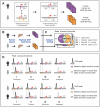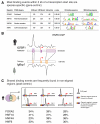Tissue-specific transcriptional regulation has diverged significantly between human and mouse
- PMID: 17529977
- PMCID: PMC3797512
- DOI: 10.1038/ng2047
Tissue-specific transcriptional regulation has diverged significantly between human and mouse
Abstract
We demonstrate that the binding sites for highly conserved transcription factors vary extensively between human and mouse. We mapped the binding of four tissue-specific transcription factors (FOXA2, HNF1A, HNF4A and HNF6) to 4,000 orthologous gene pairs in hepatocytes purified from human and mouse livers. Despite the conserved function of these factors, from 41% to 89% of their binding events seem to be species specific. When the same protein binds the promoters of orthologous genes, approximately two-thirds of the binding sites do not align.
Figures


References
-
- Bird CP, Stranger BE, Dermitzakis ET. Functional variation and evolution of non-coding DNA. Curr Opin Genet Dev. 2006;16:559–64. - PubMed
-
- Prabhakar S, Noonan JP, Paabo S, Rubin EM. Accelerated evolution of conserved noncoding sequences in humans. Science. 2006;314:786. - PubMed
-
- King MC, Wilson AC. Evolution at two levels in humans and chimpanzees. Science. 1975;188:107–16. - PubMed
Publication types
MeSH terms
Substances
Grants and funding
LinkOut - more resources
Full Text Sources
Other Literature Sources
Molecular Biology Databases

